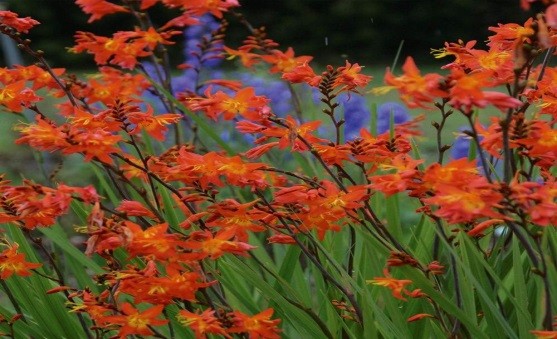TINA WOODHAMS GARDENING NOTES FOR OCTOBER
Autumn is in full swing and it’s time to enjoy the wonderful colours from the leaves to berries in our gardens and surrounding landscapes, and taking in the harvest of fruits and vegetables.
This month marks the start of the annual leaf drop. Keep lawns, borders and pathways clear by regularly raking up fallen leaves and store in a leaf mould bin or heap to rot down. Remember to clear fallen leaves and moss from guttering, including the greenhouse and shed to ensure maximum rainfall collection in water butts.

Empty pots and hanging baskets with summer bedding by removing all dead and decaying plant material, and plant up for autumn colour. Cyclamen, dwarf chrysanthemum, pansies and biennials such as wallflowers provide a pleasing display. Add some springtime interest by planting small bulbs between the bedding plants – miniature narcissi, crocus, anemone and iris – these can also be planted in pots containing shrubs and small trees.
Remove any pot saucers and raise the pots off the ground using 'pot feet' (bricks will also work well) to prevent waterlogging and frost damage. It is still important to water, but do so more sparingly as the temperatures cool.
Check the local weather forecasts in case of early frosts and be ready to move tender plants under cover.
Protect your plants from the strengthening autumn winds by staking firmly and reduce the height of shrub roses to prevent windrock damage over the winter months.

In the flower borders, cut down perennials and divide. After a few years these may become overcrowded and have a tendency to develop weaker growth – by lifting, dividing and replanting in freshly composted soil the healthy new plants will improve in vigour. Crocosmia corms will multiply and grow too close together, reducing nutrient intake and leading to less flowers. By separating out congested clumps the corms will be re energised and more likely to put on a showy display next year.
Tender plants such as penstemon, fuschia and salvia should be left unpruned so that this year's stems protect the crown from frost and then cut back in spring of the following year. After cutting down, mulch the borders with well-rotted manure and garden or mushroom compost. Not only providing protection from frost, this aids improved plant growth by adding nutrients, reducing water
loss from the soil and suppressing weeds.
October is a great time to get ahead in the vegetable patch so make early sowings of hardy cultivars of onions, shallots, garlic, broad beans and peas to give an earlier crop next season. Spring cabbages can be planted out now, together with new rhubarb crowns and any existing crowns may be divided.
Harvest the final crops of beans and courgettes as well as squashes and pumpkins. Cloches can be used to cover salad leaves to prolong the cropping season and now is the time to use up any open packets of seeds before they expire.
Clear away any other old crops to deter pests and diseases, and also to give the soil some air before planting season next year.
Pick the last of the tomato crop and ripen indoors, although if they are still growing in the greenhouse and the plants look healthy you may be lucky enough to enjoy them for a few more weeks!
We may be heading towards the winter but there is always plenty to be done and much to be enjoyed in October.
Happy Gardening!